Eighty-seven Malagasy Red Cross volunteers were trained in Protection, Gender and Inclusion (PGI), Community Engagement and Accountability (CEA) and Humanitarian Principles and Values during December 2023 and January 2024 as part of the response to pre- and post-election conflicts. Twelve (12) Malagasy Red Cross partners also had an orientation session on the three themes. A training of trainers session preceded the cascade training of volunteers, from 11 to 16 December 2023. Among these volunteers, 27 relay disseminators from 09 at-risk regions are now trainers and have thus acquired a better understanding of what the CEA is, are able to identify the essential information they need to know about the community in order to work effectively with it, improve their communication skills with communities and master the various methods for facilitating community participation in the planning and management of activities. There were also sessions on the basics of managing the community feedback mechanism, and on the tools and working methods of the Malagasy Red Cross. During this training, in collaboration with the SIFAKA studio, one of their journalists gave these volunteers a capacity-building session on the concepts of radio broadcasting, including basic concepts on the form, content and purpose of information. The aim of the session was to strengthen the skills of the volunteers to ensure better dissemination of information through the media. Subsequently, from 25 to 28 January 2024, in the Analamanga and DIANA regions, 60 volunteers were trained on the same three topics, with the exception of radio broadcasting, with explanations adapted to local contexts.
It is essential to make communities and all political forces aware of the mandate, role, mission and principles of the Red Cross, as well as the feedback mechanism in place, particularly in times of crisis, while emphasising the principles of neutrality and impartiality. This will ensure that staff and volunteers have access to the field and avoid any confusion with other actors in the response, as well as any reputational risk for the National Society. Even after the crisis, these volunteers are able to continue cascade training and carry out key activities to engage and be accountable to the community.
Formation des volontaires et session d’orientation des partenaires de la Croix-Rouge Malagasy sur l’engagement communautaire et la redevabilité (CEA) pour une intervention humanitaire efficace lors des situations de crise et/ou d’urgence
87 volontaires de la Croix-Rouge Malagasy ont été formés sur la Protection, genre et inclusion (PGI), l’engagement communautaire et la redevabilité (CEA) ainsi que sur les principes et valeurs humanitaires au cours des mois de décembre 2023 et janvier 2024 dans le cadre des réponses aux conflits pré et post élection. Douze (12) partenaires de la Croix-Rouge Malagasy ont également eu une session d’orientation sur les trois thématiques. Une formation des formateurs a précédé les formations en cascade des volontaires, du 11 au 16 décembre 2023. Parmi ces volontaires, 27 relais diffuseurs , issus de 09 régions à risques sont maintenant des formateurs et ont ainsi acquis une meilleure compréhension de ce qu’est le CEA, sont capables d’identifier les informations essentielles à connaître sur la communauté pour travailler efficacement avec elle, d’améliorer leurs compétences en communication avec les communautés et de maîtriser les différentes méthodes pour faciliter la participation de la communauté à la planification et à la gestion des activités. Des sessions portant sur les bases de la gestion du mécanisme de retour d’informations communautaires, ainsi que sur les outils et méthodes de travail de la Croix-Rouge Malagasy, ont également été abordées. Aussi, durant cette formation, en collaboration avec le studio SIFAKA, une de leurs journalistes a dispensé à ces volontaires une session de renforcement de capacité sur les notions de l’animation radiophonique dont les concepts de base sur la forme, le contenu et l’objectif de l’information. Cette session avait pour objectif de renforcer les acquis des volontaires pour assurer une meilleure diffusion des informations à travers les médias. Par la suite, du 25 au 28 janvier 2024, dans les Régions Analamanga et DIANA, 60 volontaires ont été formés sur les trois mêmes thématiques, à l’exception de l’animation radiophonique, avec une adaptation des explications en fonction des contextes locaux.
Il est essentiel de sensibiliser les communautés et toutes les forces politiques sur le mandat, le rôle, la mission et les principes de la Croix-Rouge, ainsi que sur le mécanisme de retour d’informations en place, en particulier en période crise, tout en mettant l’accent sur les principes de neutralité et d’impartialité. Cela garantira l’accès du personnel et des volontaires au terrain et évitera toute confusion avec d’autres acteurs de l’intervention, ainsi que tout risque de réputation pour la Société Nationale. Même après la crise, ces volontaires sont en mesure de poursuivre les formations en cascade et de mener les activités clés pour engager et être redevable envers la communauté.

In this blog, Papua New Guinea Red Cross Society (PNGRCS) volunteer Mairi Ovia, recounts her experience of engaging with community members on the Covid-19 vaccination in Papua New Guinea:
“In this story I will be sharing my experience of 3-day community engagement and accountability work my fellow volunteers and I carried out from the 10th to the 12th of October 2023.
Community feedback collection was a very interesting experience for me, personally, as I had the opportunity to meet and speak with different people from different places, both young and old, from different backgrounds and with different opinions and views. Apart from our community my colleagues and I decided to engage with people at Unity Mall (a local SME Marketplace), Lareva Market (the main market in the Hohola suburb) and the 3 Mile suburb area surrounding the PNG Red Cross Society Headquarters. As well as that, featured in this writing will be the story of a young man and his siter who are taking care of their other 6 siblings.
On Tuesday, 10th October, on a dull and rainy afternoon, my colleagues and I decided to start our community engagement work at the Unity Mall. Being an SME Marketplace, Unity Mall was crowded with highly educated, middle to high class individuals and groups. Many people, upon hearing that we wanted to talk to them about COVID-19 vaccine, were reluctant to participate but obviously we also found some community members who were happy to talk to us. For the latter group of people, we asked them if they have any questions about COVID-19 vaccine. Among those who engaged with us in vaccine conversation most of the people who had taken vaccine said, they had no choice but to get vaccinated because they needed to travel overseas, and the vaccine was a requirement. For those who were reluctant to get the vaccine, some said they believe COVID-19 was over they do not feel the need of vaccine anymore and some feared side effects.
After listening to their feedback, I wrote it in the feedback form and answered the questions with the help of information education and communication (IEC) materials we were given before engaging with the communities.
After listening to their feedback, I wrote it in the feedback form and answered the questions with the help of information education and communication (IEC) materials we were given before engaging with the communities. I went through the IEC together with the community members, mostly found the answers to their questions in the IEC. For the questions I could not answer there and then, I referred them to go to nearest health center to get the answers. I also gave the IEC to people who wanted to take those. It was really helpful to have those printed answers with us to answer questions from the community members mostly to explain why COVID-19 vaccine is important and specially to explain vaccine side effects are normal.
The next day, Wednesday 11th October, we agreed to start community feedback collection at Lareva Market. As we were approaching the entrance to the market, seeing us in our Red Cross vests carrying piles of papers and pamphlets, the people were already calling out to us and asking what we were trying to do. As we approached each individual and group, we explained to them what we were doing, at the same time writing their feedback in our forms, answering their questions and issuing them with IEC materials for further information. Misunderstanding us, some people refused to engage with us as they thought we were there to administer the vaccine shot to them.
While collecting community feedback in the market I came to know and realize how unaware many people were of the Covid-19 Vaccine.
While collecting community feedback in the market I came to know and realize how unaware many people were of the Covid-19 Vaccine. This saddened me more than it frustrated me. Reason being that all of those who had no idea what the vaccine was, were elderly people – one of the vulnerable groups of people, yet they had little to no knowledge of the vaccine. Before leaving the market this group of elderly people asked if we could go back again in a bigger group and do an awareness on the vaccine as they felt they needed to be educated more on it.
On the afternoon of the same day, I decided to talk to certain individuals in my community. One of which was a community leader and elder, along with his wife. This elder is also the Chairman of the Law-and-Order Committee in the neighborhood. The elder was very pleased with the initiative that Papua New Guinea Red Cross Society was taking in trying to educate people on the vaccine and nothing to worry about its side effects. He further requested for an awareness drive to be done in the community. The community elder has been vaccinated, however, his wife was yet to get vaccinated. She is afraid to get vaccinated because she has got some underlying health issues and fears the side effects the vaccine might have on her.
After talking to the community leader, I had the chance to talk to a 20-year-old young man who also resides in my community. He is the second eldest of seven siblings born to a local woman from Gulf Province and a man of Malaysian origin. The couple married 25 years ago and had their first child 3 years after marrying. Unfortunately, the mother of these seven children lost her battle to Cervical Cancer in June of 2022. She has left behind her seven children – the eldest is a 22-year-old young lady and the youngest an 8-year-old boy – to live with their father who is unemployed and a foreigner. These seven siblings along with their father live with their late mother’s extended family in her maternal grandfather’s house. This young man and his older sister had to drop out of school to take care of their five younger siblings. Making the ends met is a battle for this family. I thought COVID-19 vaccine was the last thing the young man would prioritize, he pleasantly surprised me saying he actually has got vaccinated.
The last day of our community work, Thursday 12th October, my colleagues, Michelle and Mark, and myself, did the rest of our vaccine engagement in the 3 Mile suburb. Starting in the neighborhood where the Red Cross Headquarters is located, the people were friendly and willing to participate in the conversation.
After we had finished there, we went to the main bus stop outside the Port Moresby General Hospital. The people there were quite ignorant and unwilling to participate in the conversation so not much community feedback was collected. As Michelle and Mark proceeded toward the Shady Rest Hotel, I decided to engage with people at the Susu Mama’s Hospital carpark and waiting area. There I had the opportunity to speak with a good number of expectant and lactating women. Some of which were reluctant to talk, while others were happy to share their opinions, views and concerns about the vaccine.
All in all, my experience, I would say, was one of a kind. Every individual I had a chat with shared, a different story, a different opinion, a different view and a different concern.
All in all, my experience, I would say, was one of a kind. Every individual I had a chat with shared, a different story, a different opinion, a different view and a different concern. Every time I spoke to someone my emotions would vary, depending on what the individual was sharing with me. I found myself being so saddened at times and then frustrated the next moment. For sure this experience was new for me, challenging at some point but most definitely eye-opening and educating. I am personally very grateful to have been part of this project as I have learnt so much from this experience.”
This blog was written by Mairi Ovia, Papua New Guinea Red Cross Society (PNGRCS) volunteer.
The Malian Red Cross (CRM), in partnership with the Dutch Red Cross (NLRC), the Canadian Red Cross (CRC), the Danish Red Cross (DRC) and with the support of the International Federation of Red Cross and Red Crescent Societies (IFRC), is embarking on a journey to institutionalise the Community Engagement and Accountability (CEA) approach.
After attending a 5-day Training of Trainers course given by IFRC experts in Cameroon, Fatoumata Sow, the national CEA coordinator, with the support of Philippe Onana (CRD) and Camilla Chatenier, delegate (NLRC) organised two national training courses. The first one took place from 12 to 14 December 2022 and was addressed to the Regional Secretaries and Project Managers.
The first objectivee of this training was to strengthen the capacities of the participants on the integration of CEA in the programmes, to present the CEA Boost pilot project, supported by the NLRC, which aims at setting up a feedback mechanism in the regions of Kayes, Koulikoro and Sikasso. This workshop was an opportunity to share with the participants the steps that the project team intends to follow for the implementation of the feedback mechanism, the sharing of IFRC tools supporting CEA activities, but also to learn from colleagues who have already implemented similar activities.
The second objective was to develop a document that sets out the CRM’s Standard Operating Procedures (SOPs) for managing complaints and sensitive information. The intention was that participants (heads of departments, project managers, regional secretaries of Malian Red Cross branches) would contribute to the CRM SOPs for the management of claims and sensitive information, particularly on roles and responsibilities, data flow, handling of sensitive information and handling of parties involved in the cases. One of the unexpected outcomes of this workshop was the creation of a drafting committee for the CRM SOPs for the management of complaints and sensitive information that can revise the document so that it best fits the reality of Malian Red Cross.
The next steps in this process are to support the team in the use of the shared tools and the sharing of lessons learned by the branches concerned. In particular, in terms of the difficulties and strengths in implementing the feedback mechanism in the regions of Kayes, Koulikoro and Sikasso as well as the programmatic benefits that the field teams will have gained from the project.
The Mali Red Cross and Netherlands Red Cross teams are eager to see how CEA unfolds in these branches of CRM!
This CEA workshop is a game changer for me as regards how activities will be carried out in my branch. It will add a lot of spice to our activities as I have learnt how to listen, document, analyse and interpret feedback data into information that can be used to make activities more effective.”
Peter Ochu, CEA FP Kaduna State, Nigeria.
Peter Ochu is one of the participants at the a 4-day Community Engagement and Accountability workshop organised by the Nigerian Red Cross Society (NRCS) with the support of the International Federation of the Red Cross (IFRC) with the participation of 22 program officers from the 11 states where the hunger crisis project is being implemented. The workshop which was aimed at equipping the branch field officers with the necessary skills on how to put communities at the centre of our activities for effective programming featured real-time group exercises on how to mainstream CEA in all activities and how to document their feedback.
Closing the feedback loop is one of the most interesting part to me during this workshop. It is important that we respond to community feedback in such a way that answers all questions from community members.
Mary Ogwa-Ike, CEA FP from Benue State Nigeria
Community Engagement and Accountability is an aspect of the Red Cross Red Crescent programming that enable us to listen to community members and get their perspective on the activity that we implement in locality as succinctly put by the CEA Delegate who facilitated the workshop, that “we are working with and for the communities, it is very important that we listen to them and act to meet their needs as well as manage their expectations”.
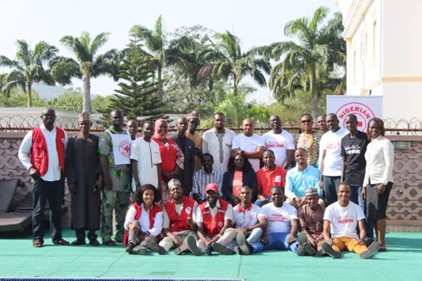
Branch officers who participated during the workshop are the Disaster Management Officers, CEA Focal Points and Planning, Monitoring Evaluation Report, PMER officers.
Data Analyst Delegate, Amadu, Senior CEA Officer IFRC, Lilian Adeogba and CEA FP for the Nigerian Red Cross Society, Mofe Amoma were among those who facilitated during the 4-day workshop.
Oksana is a Ukrainian refugee, working at the clothing distribution center in Szczecin, Poland. Volunteering has given Oksana a wide network and a sense of meaning in a difficult situation. Refugees coming into the center receive clothes and other necessities but also exchange information and talk with each other. The center has become a community of sorts, where everyone wants to help each other.
On the 23rd of February 2022 Oksana packed her swimming suit and flew from Kiev to Egypt to spend her holiday in the sun. She could never have imagined then that six months later she would still not have returned home. On the 24th of February the armed conflict started in Ukraine and Oksana’s holiday turned into a nightmare.
Oksana comes from Kiev where she worked in administration management at a big company. She is now in Poland with her daughter who joined her in June, but the rest of her family is still in Ukraine.
Travelling to Poland
Being far from her family when the conflict broke out was difficult. Oksana’s only consolation was to stay in close contact with everyone back in Ukraine, to make sure that they were okay. She could not get a plane ticket back to Ukraine, but after some time the Egyptian government organized for Ukrainians to get on a flight to Europe, to Szczecin in Poland – a place Oksana did not know from before. When she arrived, she was taken to a hotel where she stayed until she was moved to permanent housing. She used the time at the hotel to start getting to know the town and her new surroundings.
For five days we were at the hotel. And during this time, we started to search everything about the city, about the situation, because at first, we don’t know what to do, what to think and what the next steps will be for us.
At the start of the conflict, Oksana’s husband was in the occupied territory of Irpin and they had managed to stay in regular contact. However, on the 5th of March, just when she flew out of Egypt, she lost contact with him. She was very worried because she knew that the conditions were hard in Irpin.
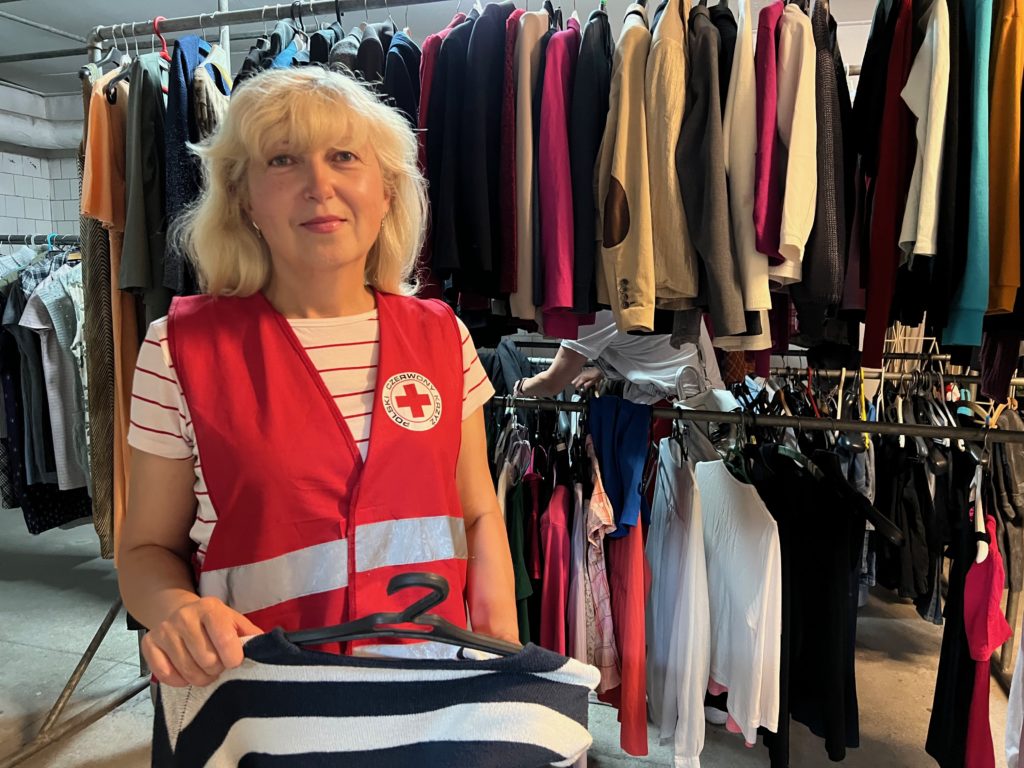
Volunteering to deal with stress and uncertainty
Oksana’s anxiety levels were running very high. It was only when she reached out to the Polish Red Cross and found the clothing distribution center, that she felt useful, and it helped to keep the anxieties in check. During the first month she worked every day, without days off from 8am to 7pm. From May she started working 3 days a week.
At the distribution center they give out clothes and other necessary products. All the refugees have travelled with little luggage and need many things, especially when seasons change. Oksana herself arrived in Poland in the winter equipped only with her summer clothes.
Many people coming to Szczecin … had never before traveled outside of Ukraine. But here they find themselves all in the same situation, traveling with only one suitcase.
Through donations from Poland and other European countries the refugees get clothes, groceries, and hygiene supplies. But the center has also become a hub where the refugees come together to talk and to exchange information and to help each other. It has become a community of sorts. Oksana gets a lot of questions from people who don’t know the language and she is happy to help them. Through her work she has developed a network and knowledge that she is happy to share with people in the same situation as her.
We share all the information that we have and that we can share with each other. There are a lot of questions now, a lot of people don’t know the language but, in this situation, we want to help everyone, and everyone want to help each other.
Oksana says that Ukrainian refugees have a strong need to talk to each other. It gives them strength to deal with their fear and their stress. Everyone is monitoring the news and are in contact with their loved ones back at home. It gives a sense of belonging getting together and to talk.
Women and children
The center gets many visits from women with babies and young children. They may have come into the country without strollers or diapers and other necessities. It is especially difficult for them, coming with their children to a foreign country in a distressing situation. But Oksana stresses that these women have a lot of strength and that they are holding up together also in these unfamiliar circumstances. They help each other and follow each other on the road. Oksana smiles when she talks about a woman who was pregnant the first time she came to the center, and now has a little baby.
Our volunteers are our heroes
Oksana is often asked why she is volunteering and not looking for a paid job. She says that volunteering gives her a sense of meaning. She has always loved people and she wants to help. It is a way to handle her stress. But she also has very positive experiences of volunteers in Ukraine. They are the real heroes, she says. It was volunteers in Irpin who helped her husband get back to Kiev. Oksana says that this thought helps her.
Oksana ends by saying that she believes in peace in Ukraine and that she will be able to go home.
This article was written by IFRC’s Minna Guigon-Sell (CEA Communications Consultant)
Carla Guananga is a social communicator. She started her career at the Red Cross working for her national society, the Ecuadorian Red Cross. She then moved to the IFRC where she found her calling with the Community Engagement and Accountability (CEA) team.
I fell in love with CEA and that’s what I do now, and I can’t imagine myself doing something different… I think working directly with the communities, improving our work, it’s amazing, it’s something magic.
When the armed conflict started in Ukraine, she wanted to help and traveled to Poland during the third surge rotation. She tells us about her job and how important Community Engagement is during an Emergency.
Poland Calling
When the armed conflict began and the surge positions started popping up, Carla immediately wanted to apply, initially planning to go during the first rotation. However, many CEA trainings took place during this period and so her departure got delayed. In the end she went for the third rotation and stayed in Poland from mid-March to mid-July.
In the beginning Carla was a bit nervous: because of the emergency of course, but also because of all the great work that had already been done there and how she would be able to catch-up. But the team was very friendly, welcoming, and helpful and she caught-up quickly – a testament to the fantastic teamwork going on there. Things also happen so fast in an emergency setting, she says, and all the great and impressive work that is developed in Poland is a product of this amazing teamwork.
Working in emergency settings
“When you are not working in an emergency it’s really easy to have a plan.”
During her two years at the IFRC, Carla has already worked in two emergencies. The first one at the very beginning of her employment: the COVID-19 pandemic. The second one the Ukraine emergency. In between, she has done many non-emergency missions and so is well-placed to tell us about the difference between non-emergency and emergency responses.
In non-emergency settings, she says, there is time to establish a plan before the trainings: to create tools and documents and to work with your national society and the focal points. In short, there is time for thorough background work. During trainings in an emergency, all this background work is not always possible. “You often have to improvise and use your creativity”, Carla laughs.
When Carla organized trainings in Poland, she created brand-new training packages, as CEA was a new concept to the communities there. She says that CEA was a whole new notion for most of the participants and it had never been applied within their national societies. So, she created new trainings to suit this context.
Another challenge was the language barriers. Being used to work in Spanish and English, this was a new situation for Carla. And it was particularly tricky, because she was in Poland but often worked with Ukrainian refugees who didn’t necessarily speak Polish either, so there was a mix of English, Polish and Ukrainian in the CEA trainings. She got all the material translated and then conducted the trainings with the support of a translator, in Polish or Ukrainian, depending on the context.
“The language barriers are really present and not only with the volunteers but with the staff as well and of course with the communities as well.”
This is a complex situation. What do you need to be successful? Carla says that she learned a lot every day, and the fact that she had an understanding boss who supported her was very important and helped her succeed in the mission.
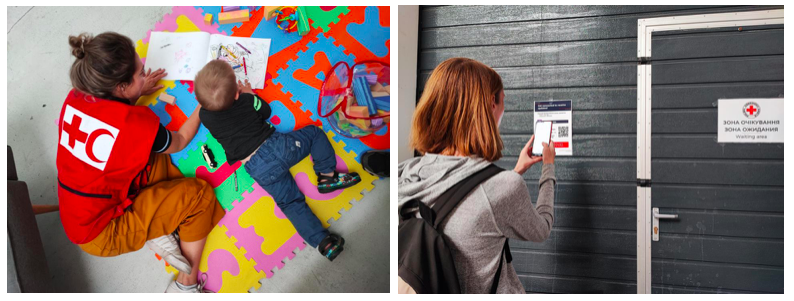
Are there typical days in emergency contexts?
Carla says that she had three different types of day. The office day, the days at the information line, and the days when she went to see the shelters or to visit the different branches.
Two or three times a week she went to the information line, which was placed outside the city. There were six amazing women, themselves Ukrainian refugees, working the line. She talked with them about issues they may have encountered, how they addressed them and what they may need to improve the response.
Other days she would go to visit branches where they had meetings, trainings or implemented programs, for example cash voucher assistance (CVA). Carla says that, during these days, an important element was to have lunch and eat together.
Because to share food with the people is a really important part to engage with people… you have really interesting conversations…that you don’t have in formal meetings.
She also made visits to the shelters and other facilities to explore opportunities to set up CVA programs. And she worked on CEA internally with the volunteers and the volunteer team.
CEA in Ukraine response
Carla felt that the CEA component was very important and appreciated in the Ukraine response. For example, when she created the feedback report for Poland, it was widely shared by the Budapest team. She felt that the information was useful and acute for the whole operation, which was really encouraging.
Carla also points out that she worked during the third rotation, which means that they already started to have some feedback from the communities and to know more than at the beginning of the emergency about the different necessities. Right now, the emergency response is going into its next phase, Carla says. It’s moving from emergency to recovery. This means starting to look at the future of the operation and what will be needed longer term – for example extending the CVA for livelihoods, shelters, and other areas.
At the end I ask Carla if there is anything else she would like to add. She says that she wants to say that she is a mom with two kids. She wants to say to all mothers out there that it’s possible to have children and at the same time to do a lot of good work for the world.
This article was written by IFRC’s Minna Guigon-Sell (CEA Communications Consultant)

Running a nation-wide Information Centre during an Emergency
When there is conflict in a country, emergency responses for the communities need to be put in place quickly. For actors in the field this can lead to new vocations. This has been the experience of Volodymyr Havryiluk and Andriy Maryniak who are running the Ukrainian Red Cross (URCS) Information Center in Lviv, Ukraine. Volodymyr, coordinator of the info center, has a degree in HR and private sector economy. Andriy, deputy coordinator and Vladimir’s right hand-man, studied history and is a teacher by training. When the conflict started all this changed and they stumbled on this new vocation at the URCS.
For Ukrainians in need for information or help, there is a number on the webpage, Facebook and Instagram of the URCS. On the other side of the call, in the background handling the processes, are Volodymyr and Andriy. With patience and understanding of the difficult situations of both the people calling in and the operators, they work tirelessly to make sure that everyone gets the information, humanitarian aid and help that they need.
A Nation-Wide Information Center
The information center is based in western Ukraine, Lviv. Lviv stands at the heart for people seeking shelter during the conflict. The information center is based in western Ukraine, Lviv. Lviv stands at the heart for people seeking shelter during the conflict. However, the night before the interview alarms were heard also here.
The center gets calls from everywhere in Ukraine. They then send the requests to the regional offices. “We try to provide only one phone number, one email address. It’s simpler, so that every part of Ukraine can call one number… It’s very hard to remember five phone numbers – one is easier.” – Andriy explains. People also hear about them through word-to-mouth. Volodymyr and Andriy talks about a time when a call came in from a small town in the eastern region. The regional branch provided them with help and suddenly calls came in from all the small towns in the region because word had spread that the URCS was working and helping.
Before the conflict, there was an existing small-scale information center, originally set-up during the COVID-19 pandemic. With the conflict, the requests increased and the need for help grew drastically. Volodymyr and Andriy assisted in expanding the center. They helped finding a place, rented an office and started working. The center, as it is today, was fully up-and-running on the 3rd of May.
The information center is now operated by 14 people, many of whom are themselves Internally Displaced Persons (IDP’s). They get up to 15-20 000 calls a week. This is a vast number of calls – do they work 24 hours a day? “No”, they respond. The center is open from 8 am to 7 pm. They monitor the peak times to have sufficient capacity then. For now, having night shifts and work during holidays is not a priority – on the contrary – they need to manage all the requests coming in during working hours. They can currently respond to approximately 30 – 50 % of the requests but are in the process of hiring more operators to be able to adequately handle all the calls.
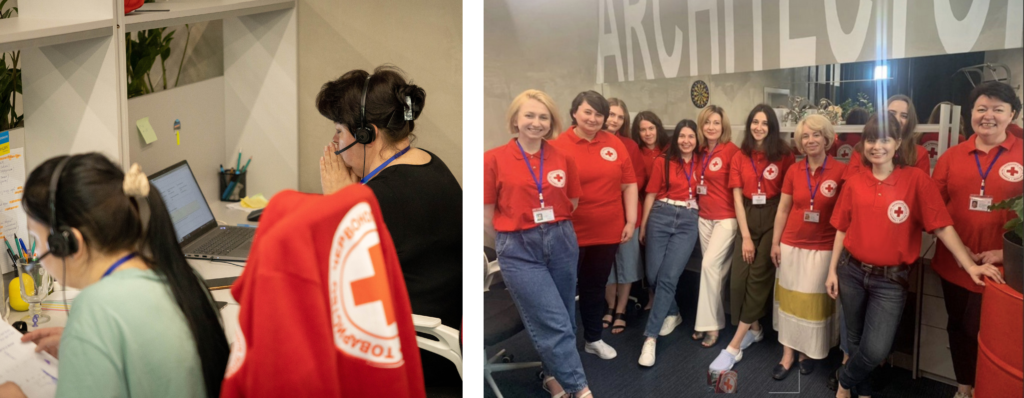
Three departments, four lines
All the calls coming in are divided into three departments depending on the request. The first department is an “ordinary” information hotline, the second is for psychological support and the third one is to Restore Family Links (RFL). Calling the general number, you get directed to the appropriate department. A fourth line that handles the requests coming in through email, messenger, and the chat-bot is recently set up.
Today, most requests concern humanitarian aid – people who lost their homes, who lost everything, get in touch. Internally Displaced Persons (IDPs) ask for temporary shelter, food, and hygiene products. When they return, they may also ask for help to start rebuilding their homes – these requests now come mainly from the Kiev region as people are starting to return there.
Many requests for financial aid also come in– people ask for vouchers and financial support programs. Many have lost their jobs and their income due to the conflict and they need help to be able to support themselves.
They also get many requests to Restore Family Lines (RFL) – there are really many of them, they say. People have lost touch of friends and family during conflict.
Volodymyr and Andriy point out that armed conflict is especially difficult for people with disabilities and older populations and that they get a lot of requests for home care. Knowing how to help is best done through active community engagement.
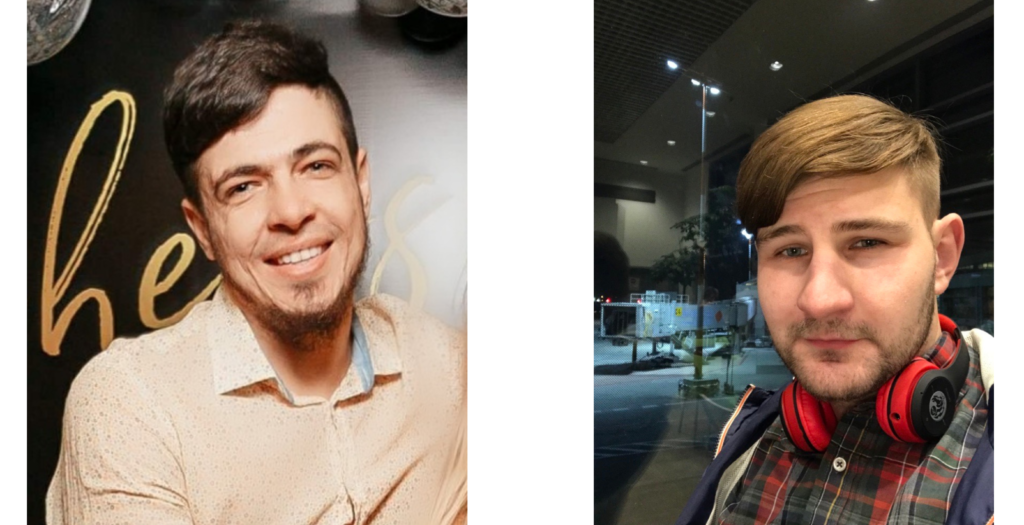
Community Feedback
This information center, at the heart of the emergency response, is an important community engagement hub in Ukraine. Most operators are IDP’s themselves and have been through traumatizing experiences, which makes them well-placed to understand and respond to the requests of the caller. They handle the requests that come in primarily in Ukrainian but also in Russian. The important thing is that everyone feels comfortable with the language they use.
The center gets information about people’s needs in real time. They can then provide information directly back to those who needs it, but they also collect feedback, conduct analysis, and notify the needs to other branches such as the URCS, IFRC and the ICRC. Getting feedback from the community is immensely important, they say, even just to be able to give the right help to each person.
Right now, for instance, there is a big medical emergency in Ukraine. People need access to both medical services and medicines. It’s difficult to get hold of, for example, high-value cancer medicines. Volodymyr and Andriy puts this into their reports so that other organizations can pick it up and hopefully provide help.
Focus on mental health and feedback sessions
Working in such high-pressure environment demands a lot of feedback sessions. There is a weekly meeting where everyone can bring their questions and they are discussed and processed together. At the beginning of each workday, Volodymyr and Andriy do a 15-minute information session to make sure the operators are up to date before the start of the day.
The center also provides mental health help. If the operator receives a very difficult call there is always a possibility to take some time off, have a break, go for a walk, or just think about it. This is important. They also have operators with a diploma in psychology who can help and give professional support in a critical situation.
This article was written by IFRC’s Minna Guigon-Sell (CEA Communications Consultant)
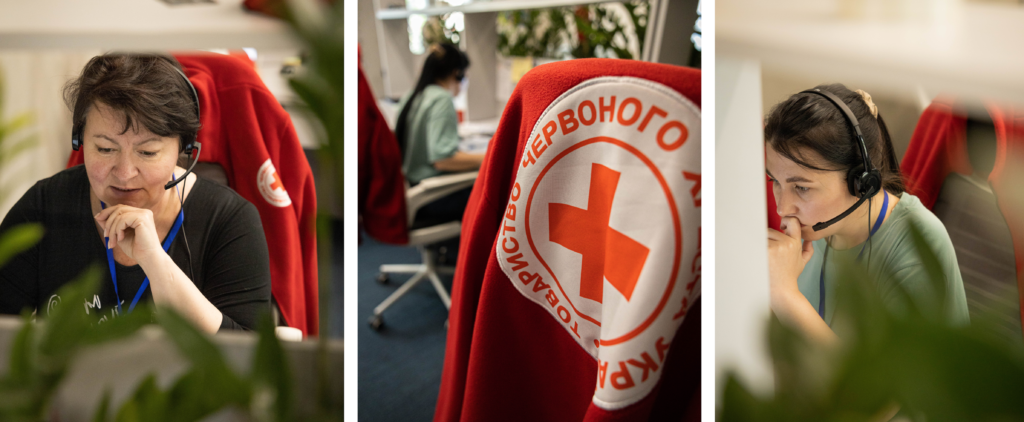
The escalation of armed conflict in Ukraine on the 24 February 2022 led to a large humanitarian crisis which overflowed to neighbouring countries. Many people had to leave their homes and go to shelters and reception centres in search for safety. Community Engagement and Accountability Surge Officers went to help people fleeing their homes in this distressing situation.
Miki Tsukamoto worked as CEA Surge Officer in Slovakia during the first rotation of the emergency. As she was there, she visited the border areas and went to the reception centers to observe how people entered the country. She wanted to give them an opportunity to tell their own stories and made two participatory videos at the end of her stay. She tells us about the process, the challenges and what she learned. Especially how important it is to make sure that the person you talk to is okay with being interviewed and that you adopt a strict “do no harm” approach.
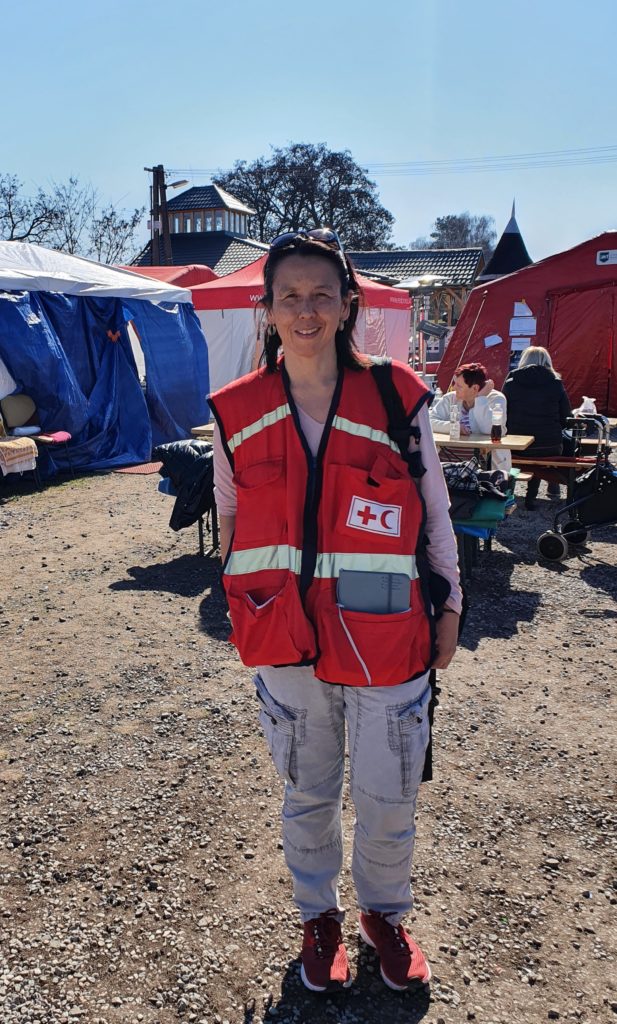
Participatory videos let you own your story
Participatory videos are films where the participants play an active role in the creation process. Miki stresses that to empower and raise a person’s voice, it is important to include them in designing, filming and editing their own videos. This ensures that the story is really owned by them. Different from a report, participatory videos also provide footage and live accounts which at times tend to capture audiences more than a static, written report. Participatory videos can also help the participant to process their own experiences and share them in an immediate way.
The ”Do No Harm” approach
But how do you approach a person in such a distressing and stressful situation? When Miki first visited a reception centre, she felt that she didn’t have the right to approach people crossing the boarders. She says that for anyone visiting the border points, it was evident that some of the people were traumatized and still trying to figure out where they would go and what they would do after fleeing their homes in Ukraine. When conducting this kind of participatory initiative, timing is key. This is why she only decided to carry out the project after having frequently visited and observed the three border areas and reception centres. At the time when she carried out the two participatory video initiatives it was close to the beginning of April, and displaced persons were staying longer at the reception centre.
Another important element is to ensure a “Do No Harm” approach. This means making sure not to approach anyone whose trauma risks being intensified through the process, or to exacerbate stress-levels. Participating in a video should be helpful and bring something to the participant. This means making sure that they want to do it; making sure of consent.
At both the reception centre and the temporary shelter making sure of consent involves carefully observing potential candidates before approaching them. For example, at the temporary shelter individuals and families are staying for differing amounts of time – they live in tents spread across the location. Many of these persons have been through a long wait at the border or have conducted a long journey, and that’s why it is important not to make the situation more exhausting. It is also important not to carry out the initiative right before departure.
Once someone had been identified, the small team of two people – Miki herself and her translator – approached them and thoroughly explained the participatory video initiative and, if they agreed to do the video, ask them to sign a written consent form in their local language. Only after this could the filming begin.
A small team of two with the help of National Society
It’s not easy to get in touch with people in distressing situations. Miki explains that it is important to make people feel at ease and to approach them in the language which is most comfortable for them. Therefore, she had the good fortune to be accompanied by an excellent Slovak Red Cross volunteer who spoke Ukrainian and Russian. She was also an excellent communicator when discussing with the displaced women. Support from the National Society (at the Headquarters and Branch level) was also essential; they provided the background information and contacts needed to approach people at the reception centres.
Location: A reception center at the beginning of an emergency
Miki has carried out many participatory video processes in various locations in the past. But she says that it was in many ways a different experience this time.
In general, she has always kept a strict community-based approach. This means entering the community first, spending time and working with the representative groups, and only then – with a strong understanding of the community- carry out the filming. But as it was the first month of an emergency operation, and the fact that the people were passing by on their way to somewhere else, it was not possible this time.
Registration centres are busy locations and in view of the conflict, the long journey and at times separation from family(ies), emotions and stress levels could be high. It was important to be aware of this when deciding on the appropriate time to carry out the activity. Having someone who could speak the local languages as an interpreter was also essential in helping putting people at ease.
Key take–aways
Miki’s key take aways from this experience are the importance to be flexible and ready to adapt to the evolving emergency context. Prioritize your activities and time them, so you can have a meaningful impact and respect a “Do No Harm” approach.
And most importantly: Listen and Learn!
This article was written by IFRC’s Miki Tsukamoto (CEA Surge Officer) and Minna Guigon-Sell (CEA Communications Consultant)
Discover participatory video resources, including templates and videos, here.
